Помни, Странник: коровы бойся спереди, коня — сзади, а химеры — со всех сторон!
Bestiary.us
энциклопедия вымышленных существБыстрый переход
- Сверхъестественное Бестиарий сериала "Сверхъестественное" ("Supernatural" series)
- Бестиарий Сапковского Бестиарий книг Анджея Сапковского о ведьмаке, волшебные существа и расы мира Геральта.
- Мир Гарри Поттера Вымышленный мир, в котором происходит действие серии романов о юном волшебнике Гарри Поттере. Действие происходит в нашем мире, в Англии, в 1990-х годах. В отличие от реального мира, среди обычных людей (маглов) живут волшебники (маги), обладающие способностью к использованию магии.
Аист
Аист — птица средневековых бестиариев, символизирующая чистую любовь — и супружескую, и сыновнюю, и родительскую
Stork — is bird which is enemy to a snake and fore-bringer of spring
Аист — птица средневековых бестиариев, символизирующая чистую любовь — и супружескую, и сыновнюю, и родительскую
Stork — is bird which is enemy to a snake and fore-bringer of spring
Аист — птица средневековых бестиариев, символизирующая чистую любовь — и супружескую, и сыновнюю, и родительскую
АистПтица средневековых бестиариев, символизирующая чистую любовь — и супружескую, и сыновнюю, и родительскую по-русскиStorkIs bird which is enemy to a snake and fore-bringer of spring in english
Cicaniae —
Асида —
Боцан —
Буско —
Буселъ мовитъ: Въскресенiемъ своимъ увесь народъ с пекла вислободилъ.
Белова О.В. "Славянский бестиарий" (102: с.65)
Специфика бестиарских трактовок животных практически всегда имеет христианскую подоплеку. Потому обычным является деление на зверей чистых, славящих Бога, и аццко-демонических прислужников Дьявола. В этом смысле аист безусловно является сугубо положительным персонажем:
Аист молвитъ: "Что есте прежде Бога судите и гадаете: что Бог дастъ, то и будетъ"
Белова О.В. "Славянский бестиарий" (102: с.51)
Кроме того, аист служит аллегорией и чистоты любви: и сыновней, и родительской, и супружеской:
Так, Физиолог говорит:
Аист — чадолюбивая птица. И когда самец приносит корм, то сторожит самка его птенца. И по очереди кормят птенцов. И сторожат гнездо свое. Так и ты, человек, ни вечером, ни утром не забывай молиться, не забывай и церкви. И никогда не одолеет тебя дьявол.
Физиолог (*)
В славянских бестиариях аист также символизировал сыновнюю любовь:
...родившим себе воздают сия птицы благодеяния то есть изнемогших кормят.
Белова О.В. "Славянский бестиарий" (102: с.57)
Интересно, что позднее такая забота о родителях перешла / распространилась на удода. Аист же остался символом супружеской чистоты и верности:
Буско — ес же буско наичистѣйшаѧ птица. Ниже бо мѫжескъ пол женскаго похотми къ смѣшенiю призываеть ни ноуждею съвъкѫплѧетсѧ.
Белова О.В. "Славянский бестиарий" (102: с.65)
Интересно, что славяне были склонны объединять под одним именем белого пеликана, журавля и аиста. Совокупно их именовали "боцан": "Бусюл, или боцан жеравль бѣлыi или стергъ. или неѧсыть все то едино" (102: с.65). Неясыть, собственно, это тоже один из вариантов именования пеликана. Такое положение вещей не удивительно, ведь до XIX века аист среди восточных славян натурально был известен только беларусам и украинцам. Известно, что до того на Россию его ареал не распространялся.
Еще один вариант названия аиста — (х)асида (внимание — не путать с бестиарским страусом ассидой). Это книжное наименование, ведущее свое происхождение от древне-еврейского חוריתא ("хасида"), что дословно переводится как "Белая" или даже "Белая дейя*".
"Кто такая хасида? — Это белая дейа. — А чему она называется хасида? — Потому что проявляет милосердие по отношению к своим подругам".
Трактат Хулин, 63а, от имени рава Иехуды (**)
Вообще талмудический интерес к бестиарской тематике весьма специфичен и имеет откровенно гастрономический привкус — раббейну Иерухам (XIII-XIV века, Прованс, Испания), пишет:
"Сигония, которая гнездится на высоких домах — это чистая птица, как гусь. И ноги у нее широкие, как у гуся, и известно, что она — не хищник. Я получил по традиции, что это — чистая птица. И видел несколько мест, где их разрешают в пищу".
Раббейну Иерухам (**)
Аналогично рассуждал и раббейну Ашер (РОШ) (XIII-XIV века, Германия-Испания):
"Знай, что в нашей земле <видимо, в Германии> и в Испании не едят птиц, которые гнездятся на домах и едят лягушек и называются на их языке "сигония", а мы называем ее "хасида", потому что такую традицию мы получили в наших землях. А что делать с теми местами, где их едят? Они скажут тебе, что это чистая птица, и так они получили по традиции, что она чиста".
Раббейну Ашер (**)
Сигония — это латинское название аиста. Вот как Исидор Севильский объясняет его происхождение:
Аисты названы именем вроде "cicaniae", по издаваемому ими звуку, который, как известно, они производят скорее ртом, нежели голосом: щелкая клювом. Аисты, провозвестники весны, живут стаей, враждебны змеям, перелетают моря, собравшись вместе, и вереницей следуют в Азию. Вороны служат им вожаками, и аисты следуют за ними, словно войско. Замечательна нежность аистов к детенышам: ведь они согревают неоперившихся птенцов, вырывая свой собственный пух. Сколько времени аисты выкармливают своих птенцов, столько и птенцы, в свою очередь, кормят состарившихся родителей.
Исидор Севильский "Этимологии". Глава 7 "О птицах", 16-17 (118)
А первым на аиста обратил внимание, видимо, Плиний:
XXXI. Ciconiae quonam e loco veniant aut quo se referant incompertum adhuc est. e longinquo venire non dubium eodem quo grues modo, illas hiemis, has aestatis advenas. abiturae congregantur in loca certa, comitataeque sic ut nulla generis sui relinquatm (nisi captiva et serva) ceu lege praedicta die recedunt. nemo vidit agmen discedentium, cimi discessurum appareat, nec venire sed venisse cemimus ; utrumque nocturnis fit temporibus, et quamvis ultra citrave pervolent, numquam tamen advenisse usquam nisi noctu existimantur. 62 Pythonos Comen vocant in Asia patentibus campis ubi congregatae inter se conmurmurant, eamque quae novissima advenit lacerant, atque ita abeunt; notatum post idus Augustas non temere visas ibi. sunt qui ciconiis non inesse linguam confirment. honos iis serpentium exitio tantus ut in Thessalia capital fuerit occidisse eademque legibus poena quae in homicidam.
63 XXXII. Simili anseres quoque et olores ratione commeant, sed horum volatus cernitur. Libumicarum more rostrato impetu feruntur, facilius ita findentes aera quam si recta fronte inpellerent; a tergo sensim dilatante se cuneo porrigitur agmen largeque inpellenti praebetur aurae. colla inponunt praecedentibus, fessos duces ad terga recipiunt. (ciconiae nidos eosdem repetunt. genetricum senectam invicem educant.) olorum morte narratur flebilis cantus, falso, ut arbitror ahquot experimentis. idem mutua carne vescuntur inter se.
Gaius Plinius Secundus "Naturalis Historia", X.31-32.61-63 (112: Vol.III, p.330-332)
Аисты используют травы душицы в качестве лекарственного средства, когда они больны. Никто не знает, куда аисты отправляются или откуда они прибывают во время миграции, они отправляются и прибывают только ночью. Когда они готовятся к отлету, все они собираются в определенном месте и отправляются вместе, как будто соответствующая дата была установлена заранее. Некоторые говорят, что аисты не имеют языка. Они высоко ценятся в некоторых местах за свою способность убивать змей. Аисты возвращаются в то же гнездо каждый год, и заботиться о своих родителях в старости.
Плиний "Естественная история". Книга 10, 31-32 (61)
P.S. А еще есть люди-аисты.
Stork is bird which is enemy to a snake and fore-bringer of spring.
XXXI. Ciconiae quonam e loco veniant aut quo se referant incompertum adhuc est. e longinquo venire non dubium eodem quo grues modo, illas hiemis, has aestatis advenas. abiturae congregantur in loca certa, comitataeque sic ut nulla generis sui relinquatm (nisi captiva et serva) ceu lege praedicta die recedunt. nemo vidit agmen discedentium, cimi discessurum appareat, nec venire sed venisse cemimus ; utrumque nocturnis fit temporibus, et quamvis ultra citrave pervolent, numquam tamen advenisse usquam nisi noctu existimantur. 62 Pythonos Comen vocant in Asia patentibus campis ubi congregatae inter se conmurmurant, eamque quae novissima advenit lacerant, atque ita abeunt; notatum post idus Augustas non temere visas ibi. sunt qui ciconiis non inesse linguam confirment. honos iis serpentium exitio tantus ut in Thessalia capital fuerit occidisse eademque legibus poena quae in homicidam.
63 XXXII. Simili anseres quoque et olores ratione commeant, sed horum volatus cernitur. Libumicarum more rostrato impetu feruntur, facilius ita findentes aera quam si recta fronte inpellerent; a tergo sensim dilatante se cuneo porrigitur agmen largeque inpellenti praebetur aurae. colla inponunt praecedentibus, fessos duces ad terga recipiunt. (ciconiae nidos eosdem repetunt. genetricum senectam invicem educant.) olorum morte narratur flebilis cantus, falso, ut arbitror ahquot experimentis. idem mutua carne vescuntur inter se.
Gaius Plinius Secundus "Naturalis Historia", X.31-32.61-63 (112: Vol.III, p.330-332)
XXXI. Where exactly storks come from or where they go to has not hitherto been ascertained. There is no doubt that they come from a distance, in the same manner as do cranes, the former being winter visitors and the latter arriving in summer. When about to depart they assemble at fixed places, and forming a company, so as to prevent any of their class being left behind (unless one captured and in slavery), they withdraw as if at a date fixed in advance by law. No one has seen a band of storks departing, although it is quite clear that they are going to depart, nor do we see them arrive, but only see that they have arrived; both arrival and departure take place in the night-time, and although they fly to and fro across the country, it is thought that they have never arrived anywhere except by night. There is a place in Asia called Snakesdorp with a wide expanse of plains where cranes meet in assembly to hold a palaver, and the one that arrives last they set upon with their claws, and so they depart; it has been noticed that they have not frequently been seen there after the first fortnight of August. Some persons declare that storks have no tongue. They are held in such high esteem for destroying snakes that in Thessaly to kill them was a capital crime, for which the legal penalty was the same as for homicide.
XXXII. Geese and swans also migrate on a similar principle, but the flight of these is seen. They travel in a pointed formation like fast galleys, so cleaving the air more easily than if they drove at it with a straight front; while in the rear the flight stretches out in a gradually widening wedge, and presents a broad surface to the drive of a following breeze. They place their necks on the birds in front of them,and when the leaders are tired they receive them to the rear. (Storks return to the same nest. They nourish their parents' old age in their turn.). A story is told about the mournful song of swans at their death—a false story as I judge on the strength of a certain number of experiences. Swans are cannibals, and eat one another's flesh.
Pliny the Elder "Natural History", X.31-32.61-63 (112: Vol.III, p.331-332)
16. Ciconiae vocatae a sono quo crepitant, quasi cicaniae : quem sonum oris potius esse quam vocis, quia eum quatiente rostro faciunt. Hae veris nuntiae, societatis comites, serpentium hostes, maria transvolant, in Asiam collecto agmine pergunt. Cornices duces eas praecedunt, et ipsae quasi exercitus prosequuntur. 17. Eximia illis circa filios pietas; nam adeo nidos inpensius fovent ut assiduo incubitu plumas exuant. Quantumautem tempus inpenderint in fetibus educandis, tantum et ipsae invicem a puUis suis aluntur.
Isidori Hispalensis Episcopi Etymologiarum Sive Originum, XII.7.16-17 (88)
16. Storks (ciconia) are named from the chattering noise they make, as if their name were cicania (cf. canere, i.e. “sing”). Although this sound is made with the mouth, it is not really a vocal call, because they produce it with a clapping of their beak.They are messengers of the spring, socially companionable, enemies of snakes; they cross the sea, and migrate into Asia in a gathered flock. Crows go ahead of them as leaders, and the storks follow just like an army. 17. They have an uncommon concern for their offspring, for they guard their nestlings so earnestly that they pull out their own feathers in assiduous brooding. Whatever length of time they give to rearing their chicks, for that same span they are themselves nourished in turn by their offspring.
Isidore of Seville "Etymologies", XII.7.16-17 (1175: p.264)
Онлайн источникиАнлайн крыніцыŹródła internetoweОнлайн джерелаOnline sources
Статус статьиСтатус артыкулаStatus artykułuСтатус статтіArticle status:
Форматка (почти готовая статья, на завершающей стадии оформления материала)
Подготовка статьиПадрыхтоўка артыкулаPrzygotowanie artykułuПідготовка статтіArticle by:
Адрес статьи в интернетеАдрас артыкулу ў інтэрнэцеAdres artykułu w internecieАдрес статті в інтернетіURL of article: //bestiary.us/aist

Культурно-географическая классификация существ:
Культурна-геаграфічная класіфікацыя істот:
Kulturalno-geograficzna klasyfikacja istot:
Культурно-географічна класифікація істот:
Cultural and geographical classification of creatures:
Физиологическая классификация:
Фізіялагічная класіфікацыя:
Fizjologiczna klasyfikacja:
Фізіологічна класифікація:
Physiological classification:
Форумы:
Форумы:
Fora:
Форуми:
Forums:
Еще? Еще!
Люди-аисты — в средневековых бестиариях племя людей, превращающихся в аистов
Феникс — мифическая птица, сжигающая себя и возрождающаяся из пепла
Керасты — в античности и средневековых европейских бестиариях рогатая гадюка
Гидрус — в средневековых бестиариях, змея, заползающая спящим крокодилам в пасть, и разрывающая им внутренности
Люди-журавли — в средневековой европейской литературе чудовищное племя людей с длинными как у журавлей шеями
Грифон — крылатый лев с орлиными передними лапами и головой, ведущий свой род из греческих мифов
Бонакон — тварь безобидная, однако ж к преследователю тылом оборачивающаяся и ветрами оного поражающая
Гадюка — в античных трудах, средневековых бестиариях и околоцерковной литературе змея, срамным и неестественным образом совокупляющаяся
Якул — змея, стремительно бросающаяся на свою жертву
Левкрота — в средневековых бестиариях существо, напоминающее лошадь, с пастью до ушей, способное подражать человеческой речи
Парандр — в античных источниках и средневековых бестиариях зверь, который может менять свой внешний вид
Блемии — в средневековых бестиариях племя безголовых людей с лицами на груди
Донестры — в средневековых европейских рукописях чудовищное племя каннибалов-полиглотов
Онокентавр — разновидность кентавров, комбинация человека и осла
Аспид — в христианстве, средневековых европейских бестиариях и в славянской мифологии крылатая змея, опустошающая земли
Ассида — в средневековых бестиариях существо, которое ноги имеет верблюжьи и крылья птичьи
Единорог — в мифологии (а в последствии и в фэнтези) конь с единственным рогом во лбу, символ духовной чистоты
Эал — в средневековых бестиариях и европейской геральдике составное животное с подвижными рогами
Кинокефалы — люди с головами собак или шакалов
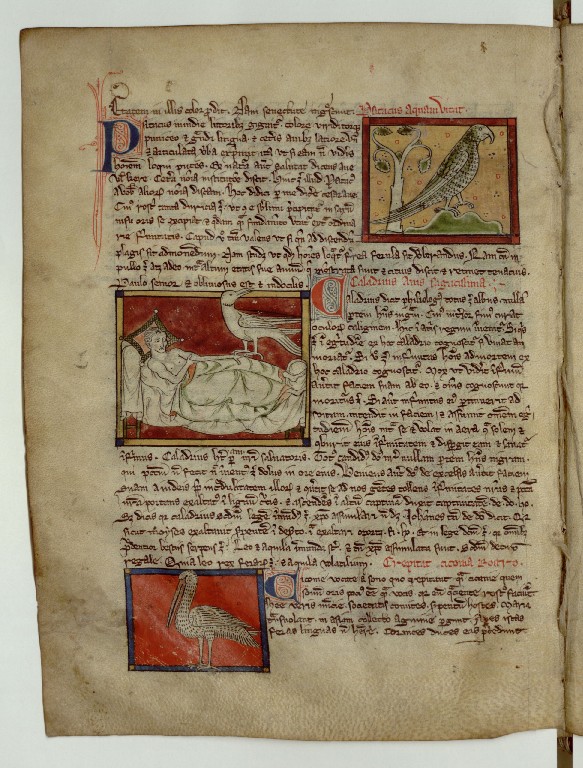
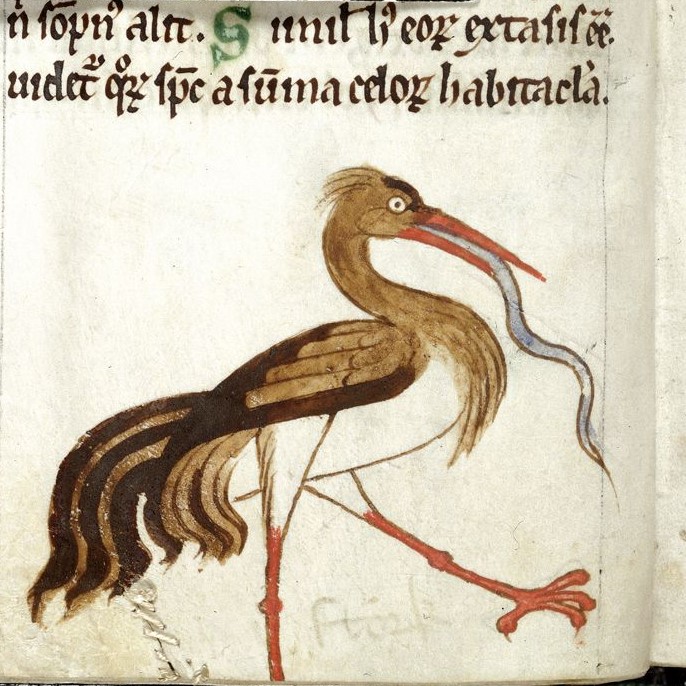
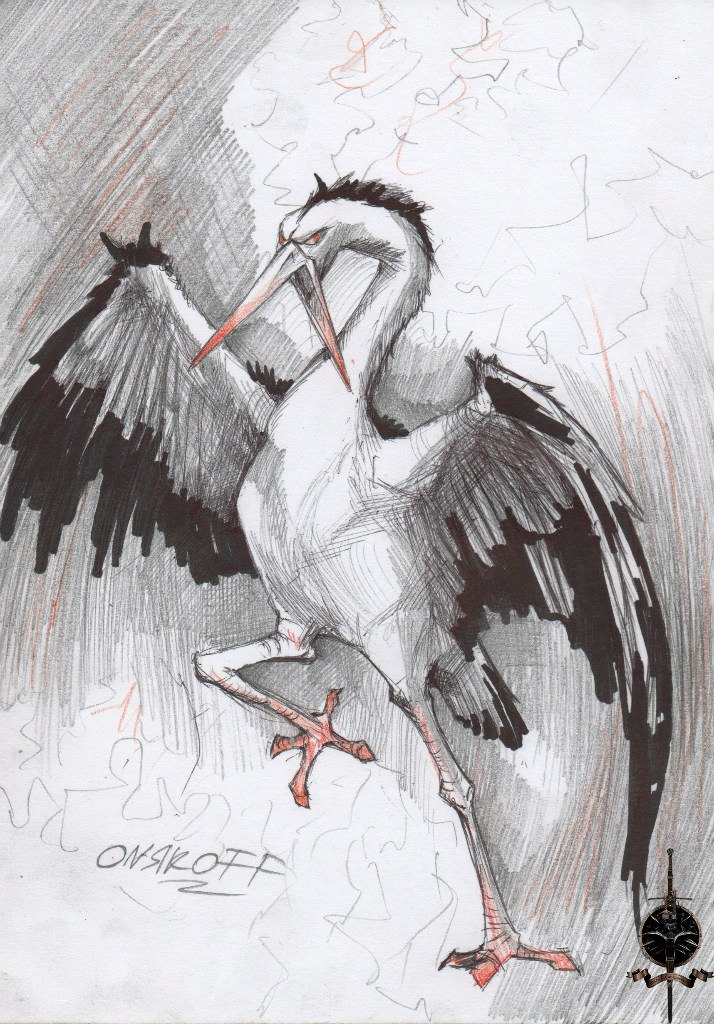
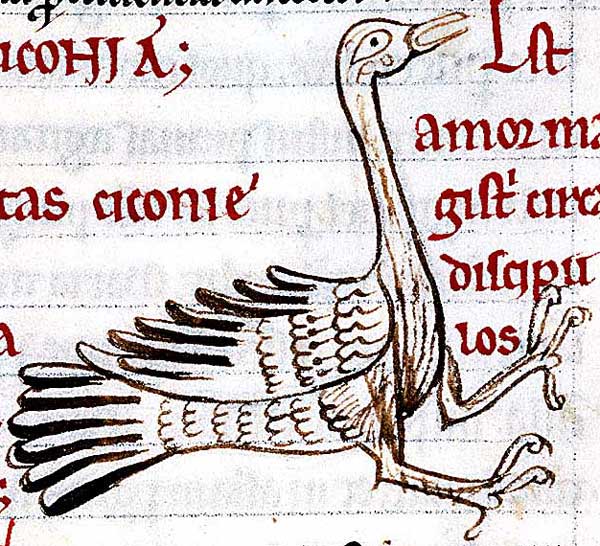
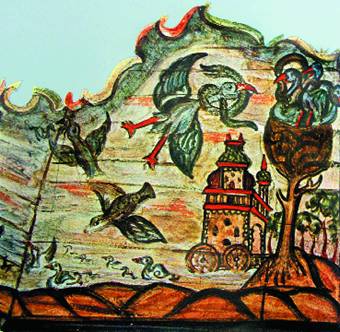
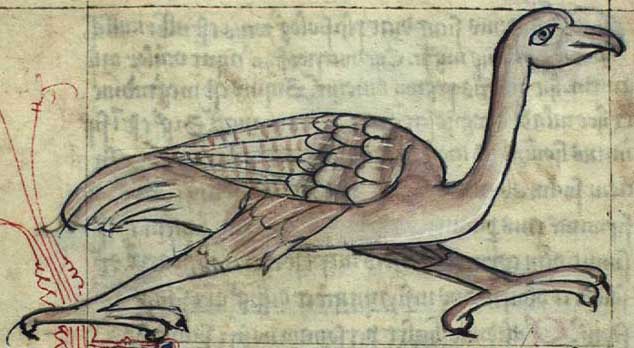
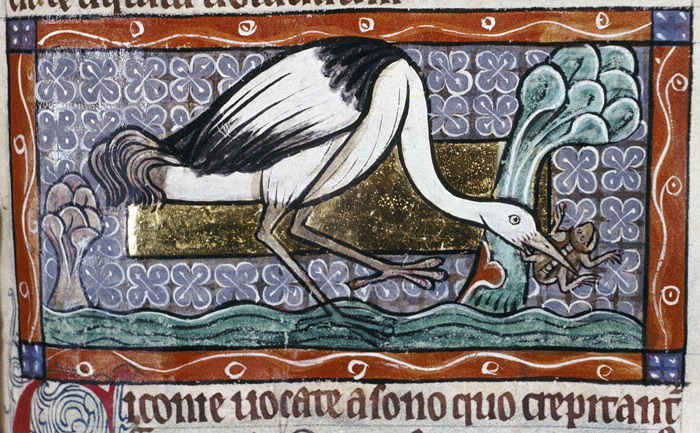
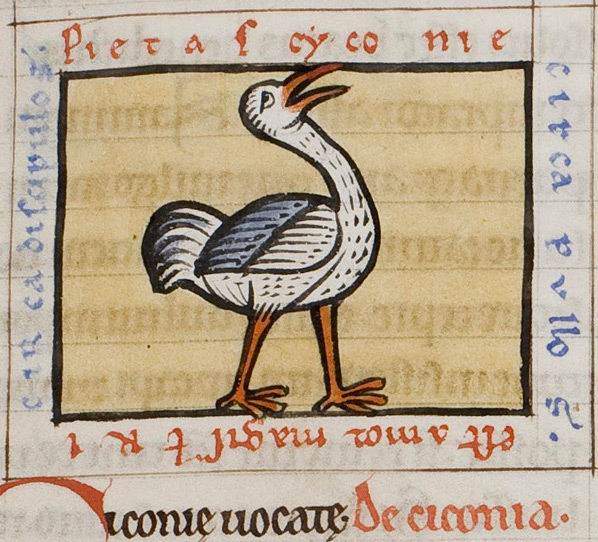
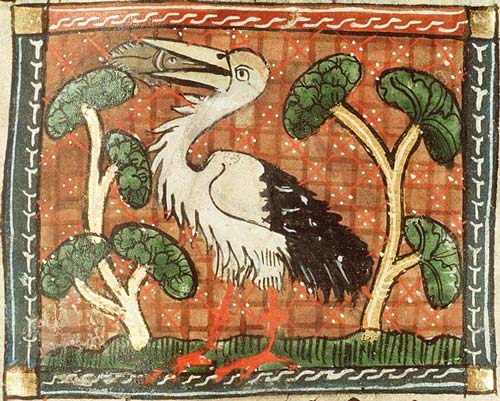
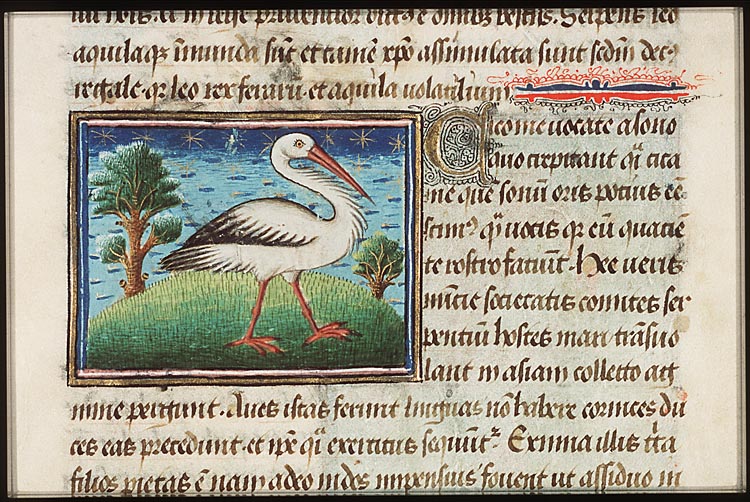
Comments
Думаю, во избежание путаницы, стоит увязать как-то со страусом, который ассида ;)
Согласен. И еще аистиных имен добавлю.
Экстранаучная классификация
- статус — существа
- домен — животные
- тип — птицы
- класс — бестиарские птицы
- семейство —
- род — Аисты
- вид — аист бестиарский
Физиология
Аист
Культурно-географическая
Средневековые бестиарии
Отправить комментарий